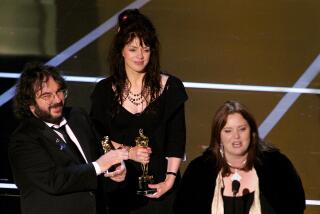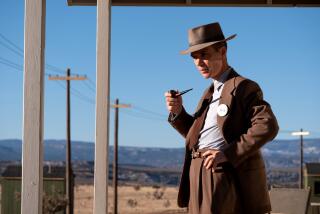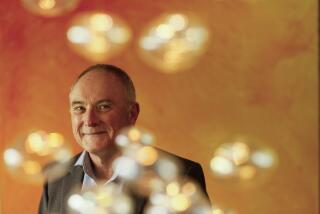Oscars 2015: Editing nominees united in commitment to storytelling
The focus that the nominees for this year’s editing Oscar have in common is a commitment to storytelling — how to create an editing style and rhythm to complement a film’s individual voice.
“There was a time it was all about fast cutting and sort of random cuts to make things seem exciting when they’re not,” said William Goldenberg, nominated for “The Imitation Game.” “It feels to me that people have taken a step backwards a little bit to get back to storytelling as important over anything. That’s what audiences want.”
FULL COVERAGE: Oscars 2015
“I think the concerns of editors today are probably in large part close to what the concerns were in the early days of cinema,” said Tom Cross, the editor of “Whiplash.” “How to create great characters and inject the most impact into stories. It’s an age-old challenge.”
The nominees make for a varied mix of styles in service of their storytelling, from the brashly frenetic to the classically restrained. The others are Joel Cox and Gary D. Roach for “American Sniper,” Sandra Adair for “Boyhood” and Barney Pilling for “The Grand Budapest Hotel.”
The editing category, in addition to being an intriguing window into movie craft, has also become a favorite among Oscar-watchers — not since 1980’s “Ordinary People” has a film been named best picture without also being nominated for editing. For those keeping track, that means “Birdman,” which has dominated many of the guild awards, may break tradition.
This is the fifth nomination for Goldenberg, who won an Oscar for “Argo,” and the third for Cox, who won for his work on “Unforgiven.” It is the first nomination for the others.
Although the craft of editing has moved from physically handling and cutting film to using sophisticated computer software that allows for seemingly infinite manipulations to layer images and sounds, many things remain the same.
PHOTOS: Oscars 2015 top nominees | Presenters | Nominee reactions | Awkward moments
“The concerns still are having a true understanding of the intent of the director and being able to pull the story out of the footage that’s shot,” Adair said from her office in Austin, Texas. “That remains the biggest challenge of a film editor, and I don’t think that’s ever changed.”
Adair already had an established relationship with director Richard Linklater when he invited her to participate in the 12-years-in-the-making project that would become the exploration of a single family in “Boyhood.” Over the ensuing years, even as the two collaborated on other films, Adair always had a set of boxes with her working materials for “Boyhood” nearby in her cutting room.
Immersed in the details of each year’s work, it wasn’t until about six years in, while watching the footage with Linklater, that the emotional weight of seeing the performers age onscreen struck Adair. “I remember turning to him and saying, ‘This is why we’re all the way we are,’” she said. “Suddenly, the cumulative effect of all the years had so much more of an impact than just seeing each individual year.”
“Whiplash” features a percussive, rhythmic editing style that plunges viewers within the mind-set of its characters. “One of the things [director] Damien [Chazelle] said to me was he wanted the film to feel like an action thriller first and a music film second,” Cross said. “He really wanted the music scenes, rehearsal and concert scenes to have a brutality to them and to feel like the boxing scenes in ‘Raging Bull.’ He generally spoke about wanting these scenes to feel like scenes out of a war movie.”
The “American Sniper” team has been working together for nearly 20 years. (Cox started working with Clint Eastwood as a filmmaker on 1976’s “The Outlaw Josey Wales.”) Their polished mix of action and personal drama includes a dazzling action set piece through a sandstorm and a disorienting cross-continental phone call between a soldier in a firefight in the Mideast and his wife, safely at home in the U.S. Eastwood’s unfussy style finds him shooting few takes, with the first often the one that ends up in the film.
“He’s the consummate director of actors,” Cox said on the phone from a shoot in Australia. “First of all, he’s an actor, and he always thinks about that. He doesn’t run them through the ringer doing takes and takes and takes. He knows what he’s doing and knows what he’s after, so it’s not trial and error. He makes our lives just so easy.”
“The Imitation Game’s” complex time-shifting structure was partly what drew Goldenberg to the project directed by Morten Tyldum, along with his curiosity to learn more about World War II code breaker AlanTuring.
“Having each time period inform the other within a really strong narrative drive, it’s a lot of what Morten and I worked on in the cutting room,” said Goldenberg. “Graham [Moore] wrote it as a puzzle, because Alan was fascinated by puzzles.”
OSCARS 2015: Complete list | Ballot | Cheat Sheet | Timeline
In working on “The Grand Budapest Hotel,” Pilling found himself on his own pan-European adventure. During filming, he worked out of the basement of the old town hall in the storybook German town where the film was shot, and he then followed Wes Anderson to England and Paris for post-production.
Pilling called Anderson “the most prepared director I’ve ever come across,” while referring to the film’s ensemble cast as “a smorgasbord of joy.”
“That was the big eye-opener, just how much meticulous detail went into the performances, both the vocal performances, the performances of the camera crew, the performances of the weather even,” Pilling said by phone from London. “If a shadow didn’t look right in the top corner of a wide shot of the hotel, we’d do something about it.”
Twitter: @IndieFocus
More to Read
Only good movies
Get the Indie Focus newsletter, Mark Olsen's weekly guide to the world of cinema.
You may occasionally receive promotional content from the Los Angeles Times.







